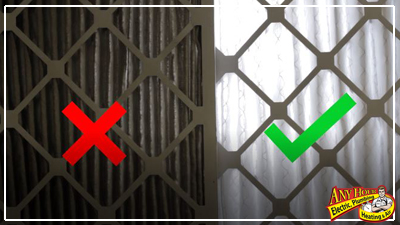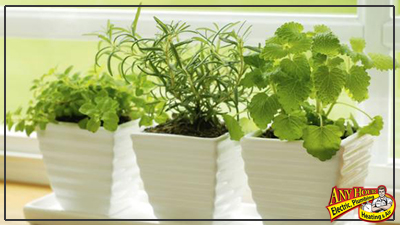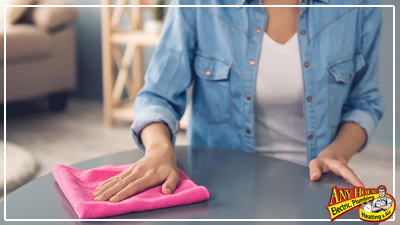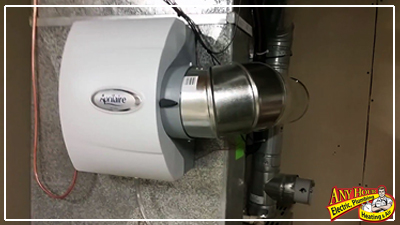6 Tips for Improving Indoor Air Quality This Winter

As one of the worst states in the nation for air quality, Utah provides its residents with regular outdoor air quality alerts. On red alert air days, we are advised to stay indoors but are we really aware of whether our indoor air is actually healthy? Indoor air quality is an important consideration, not only when the air outside is bad, but because throughout the year, we spend 90-99% of our time indoors.
Now consider this: modern homes and buildings are built to be energy efficient, well-insulated, and tightly constructed. This is great when it comes to heating and cooling costs, but it poses a significant problem when you start to think about airflow and circulation. This poor circulation means that any allergens, dust, molds, or bacteria that are brought into the home just hang out there, thriving, growing, and causing allergic reactions or sickness for the people inside.
For example, have you ever wondered why you feel more congested when you wake up in the morning? That congestion could be stale air, full of dust mites and their matter, mold, dust, volatile organic compounds (VOCS) or other irritants congregating in your room at night. The exposure all night long could be making you congested. Additionally, have you thought about why, when one person brings a sickness home, the whole house ends up getting sick? It’s because those germs and viruses hang in the air of your home without being ventilated out.
So what can you do? Here are Six Tips to Help Improve Your Indoor Air Quality:
Change Furnace Filter Frequently
Your furnace filter is the first line of defense against large particulates circulating throughout your home. Take the filter out of your furnace and hold it up to the light. If you can't see light through the filter, it's time to change it out. This helps keep large particles out of the air. To increase your filter's power, consider switching to a HEPA filter, designed to trap even more particles.
Open the Windows
Throughout the year, the air inside your home becomes increasingly stale and full of contaminants that the occupants are regularly bringing in. Obviously, guests and occupants bring germs, viruses, and bacteria from school, work, shopping centers, public transit, or elsewhere - but there are other contaminants being introduced to your home that you might not be fully aware of. For example, pets bring in dander, obviously, but also molds and mites and spores that cling to their fur. Beyond that, introducing anything that has that "new" smell - be they electronics, furniture, paint, carpet, etc. - are toxins, or volatile organic compounds (VOCS) that will then be circulated through the home. These can be metals, petroleum distillates, formaldehyde, wood treatments, cleaning products, and others. Simply opening the windows can help push some of this bad air out and allow some fresh air in. To get maximum air flow, turn the furnace off but leave your furnace fan on to help push the air.
Be advised that there are better times than others to crack your windows, however. Avoid high pollen or heavily inverted, red alert air days.

Purify with Plants
Plants are an inexpensive, decorative, and organic way to scrub some contaminants out of the air. They not only take in CO2, but they increase oxygen levels in the home, and also remove numerous other toxins, from benzene to formaldehyde, mold, and others. But not all plants are as effective as others. Some of the best are the Spider Plant, English Ivy, Boston Fern (which also acts as a natural humidifier), Peace Lily, Bamboo Palm, and Aloe Vera. Bonus: besides being an excellent air scrubber, the juice of the aloe vera plant can also soothe minor burns.

Keep Surfaces Clean
One of the simplest ways to improve indoor air quality is to keep surfaces clean. Regularly sweep and vacuum the floors to keep dust down and consistently wipe down tables and countertops to keep germs and other bacteria to a minimum. When dusting, it's also a great idea to wipe down surfaces with a rag, using furniture polish, as opposed to using a feather duster, for example, that will release the settled dust back into the air. Be sure to also keep the leaves of your plants dust-free by wiping them gently with a wet cloth. This will allow them to continue to "breathe" freely and help keep the air clean.
Use an Air Purifier
To purify the air in your home, you have two options: one-room or whole-home purifiers. Room purifiers are a great idea for bedrooms and other areas where you spend a lot of time. They help circulate the air while also helping to filter it of fine particulates. However, be aware that budget air purifiers will generally do a budget job of cleaning the air. As with most things, you generally get what you pay for in portable home air filtration systems. Make sure that your system can filter particles smaller than 2.5 microns, as these are the fine particles like mold spores and insect matter that can cause respiratory issues to those with sensitivities. You should also be aware of the square footage capacity of your one-room purifier so it is consistent with the space you want it to cover.
On the other hand, a whole-home purifier works with your HVAC system to scrub the air as it circulates through your home. This can be accomplished in a couple of different ways. Some whole-home solutions are special filters that attach to your furnace to trap particles. In other systems, UV lights are attached to the furnace so that the air entering the furnace system can be scrubbed for particles. Additionally, there are even whole-home purification systems, like the Reme-Halo that actually send hydroperoxides into the air to destroy microbials. For more information on this and other technologies, talk to your HVAC professional to see which solution might be the best fit for your family.

Humidify the Air
While this one is less about particulates in the air, a humidifying system can make a big difference when it comes to indoor air quality. Besides preventing static electric build up in carpets and clothes, it helps prevent dryness of the skin, throat, and hair, to name a few. But it also helps to keep furniture and wood floors conditioned. (Many homes are equipped with a whole-home humidifier but many homeowners aren't aware of the regular maintenance they require to keep working effectively. Click here to watch a video on how you can check your whole house humidifier yourself to see if it's working properly.)
Author: Amber Smith-Johnson
Copyright © 2018 Any Hour Services
Feb 5th 2018

